Abstract
Construction accidents occur frequently in China because the supervision of safety standards mandated by the government has not had its intended effect. In this paper, the authors propose a model to incentivize the management of safety during construction that involves the government as well as the owners and contractors in the industry. This study analyzes the principal–agent relationship involving each participant to determine their utility function and the minimum constraints on their participation, and uses this to obtain the optimal parameters to incentivize the management of safety during construction by solving for the ones related to the contractor’s effort and reward for their performance in the proposed model of incentives. Through the design of contractor incentive parameters and owner incentive parameters to further influence the government contractor and owner tripartite safety incentive model to make the model more perfect and in line with the development status of China. This study tested the proposed model using simulations. The results indicated that increasing the cost coefficient and level of the contractor’s effort increases their expected safety-related benefits, and increasing the coefficients of reward and punishment by the government reduces the contractor’s expected safety-related benefits. Moreover, the government can motivate the management of safety during construction by offering appropriate rewards and punishments. In particular, if the government increases incentives for safety, the safety-related benefits for owners and contractors decrease in the short term but increase significantly in the long term.
1. Introduction
The construction industry in China has made significant contributions to the country’s economy and society. According to the China Statistical Yearbook 2022, the total output of the construction industry increased from 9.6 trillion yuan in 2010 to 29.3 trillion yuan in 2021, a growth rate of 205%. However, the management of safety during construction has not kept pace with this rapid growth. According to the Ministry of Housing and Urban–Rural Development, the number of construction-related accidents in China from 2012 to 2020 increased from 480 to 689, and the number of fatalities due to them increased from 599 to 794.
China has paid greater attention to the management of safety during construction in recent years. The government has issued a number of policies and regulations to ensure safe production practices, but the rate of construction accidents remains high [1]. This shows that mandatory safety supervision for construction has encountered bottlenecks in practice. Such supervisions compel construction companies to passively accept safety standards with limited enthusiasm and incentives, and this limits their effect [2]. Therefore, many researchers have addressed the role of soft constraints/incentive mechanisms in safety supervision [3,4,5].
Past research on the incentives for managing safety during construction has mainly focused on safety management systems and behavioral incentives for construction personnel [6,7,8]. Few scholars have addressed incentives for contractors that are mainly reflected in contracts between them and the owners of construction companies [9,10,11]. Most scholars studied the incentive model between the government and the owner or between the contractor and the construction personnel. The study considers the incentive model between the owner and the contractor, proposes the safety incentive model between the government, the owner, and the contractor, and studies the influence of the incentive parameters of the two on the model. Contractors are the main bearers of the responsibility for safe production on site and are expected to take initiatives to fulfill their production-related responsibilities [12]. They can directly supervise the safety-related behaviors of front-line workers, and the government can participate in safe production and safety supervision along with contractors [13]. In light of the principal–agent relationship between the contractor and the owner in the context of principal–agent theory, whether the contractor operates safely directly influences the safety-related performance of the owner of the construction company [14]. The owner’s goal is to strictly follow the government’s safety standards, urge the contractor to ensure safe production, and thus guarantee the safety and economic benefits of the project [15]. Therefore, this study establishes a model of incentives in light of the roles of the government, owners, and contractors in China’s construction industry for managing safety during construction, with the aim of encouraging enterprises to exert their subjective initiative in management to improve safety.
The significance of this study is as follows: (1) Prevalent research in the area has mainly focused on managing construction safety from the perspective of punishment, but long-term punishments have exhausted room for improvements in safety. It is important to discuss issues concerning safety regulations in China from the perspective of the incentives provided for safe operation. (2) Few studies have examined safety-related incentives for construction companies. According to Chinese law, construction companies bear the main responsibility for safe construction. This study thus sets construction companies as the object of safety-related incentives. (3) The introduction of reputation as an integral part of earnings enriches models that consider only economic returns and is more in line with the current situation in China.
2. Literature Review
2.1. Supervision of Construction Safety
Safety supervision is a special public management activity in which the government supervises and controls the safety of production activities in various sectors of the industry and implements the responsibilities of the relevant actors in accordance with the pertinent laws and standards [16]. Pesek et al. (2019) claimed that a delay in communication between contractors and owners leads to information asymmetry, which reduces the effectiveness of supervision [17]. To solve this problem, some researchers have proposed establishing an information system for safety supervision. Park et al. (2014) developed such an information system for construction based on a network to assess the qualitative risk in construction management [18]. Pi et al. (2019) proposed the concept of a safety information system and a blacklist based on the safety of operations in construction engineering in China to improve safety [19]. Based on the interaction between government supervision departments and contractors, Zhang et al. (2022) proposed an evolutionary game model for the dynamic supervision of construction safety and analyzed the evolutionary strategy of the game [20].
The level of supervision of construction safety is related to the safety of the project in question. Zhang et al. (2018) analyzed the influence of participation by the stakeholders on construction safety, and their results can be used to allocate responsibilities for managing construction safety among them to improve it [21]. Lafuente and Abad (2018) studied how the characteristics of systematic and project-based operational processes influence safety management systems in terms of different performance indicators [22]. Mohammadi et al. (2018b) reviewed and refined the factors influencing the safety of construction projects and established a hierarchical structure framework to explain how the chosen factors influence their safety [23].
2.2. Incentives for Construction Safety
The issue of safety-related incentives in the supervision of construction safety has attracted considerable attention, and the relevant research has mainly focused on the internal safety-related incentives for employees of construction companies [24,25,26]. Ji et al. (2021) considered the workers’ preference for fairness to investigate safety-related incentives based on competition. They found that this increased the workers’ enthusiasm and creativity and reduced unsafe behaviors [27]. Research by Karakhan and Gambatese (2018) showed that motivating employees to operate safely in the workplace can help improve their understanding of hazards and risks in construction and thus improve safety [28]. Chughtai (2015) found that positive leadership also plays a positive role in the construction safety atmosphere, which is conducive to improving the safety performance of employees, while negative safety leadership plays a negative role in the construction safety atmosphere, affecting the safety production of enterprises [29]. Previous studies have not adequately addressed safety-related incentives for construction enterprises, where a system based on this can improve the current state of passivity related to building safety, realize active control, and improve the quality of construction safety [30].
Safety-related incentives have been researched in light of the different stakeholders in the construction industry. By considering the cooperative relationship between owners and contractors in construction, Wu et al. (2017) established a cooperative model of incentives to attain synergistic effects and enhance the overall safety-related benefits of construction projects [31]. Guo et al. (2018) noted that a dynamic mechanism of reward and punishment can improve the stability of the supervision system and optimized the relevant procedures by analyzing the interactions among the project owner, the supervising engineer, and the construction contractor [32]. Feng et al. (2020) formulated dynamic methods of punishments and incentives for government supervisors, upstream participants (UP), and downstream participants (DP) to control the quality of risk in construction projects and improve the efficiency of their supervision in China [33].
Some researchers have claimed that different combinations of incentive-based measures influence safety. Alarcon et al. (2016) showed that in terms of the rate of accidents, choosing an appropriate combination of incentive-based measures is more important than the number of measures implemented [34]. Similarly, Liu et al. (2022) pointed out that when a combination of the mechanisms of reward and punishment and the revenue-sharing mechanism is used, construction safety is better than when only one of these mechanisms is applied [35]. Hasan and Jha (2013) analyzed data from 32 construction projects in India and found that combinations of incentive-based methods as well as appropriate forms of incentives and penalties improved safety [36].
The above literature review shows that few safety-related incentives are available for construction contractors in research on safety management in China, and most of them are based on basic assumptions regarding the economic benefits of projects, to the neglect of such non-economic indicators as reputation. Construction workers are highly mobile and have uneven professional qualities. Accordingly, the management of safety during construction is characterized by randomness and dynamism, making it difficult to assess the competence of safety management by contractors. By considering the state of safety-related incentives in China and drawing lessons from research on the subject in other countries, this study constructs a model of safety-related incentives that can encourage contractors to satisfy the overall interests related to managing safety during construction while maximizing their own interests.
3. Model
Building safety incentives involves a game among multiple stakeholders. Based on the principal-agent relationship between the government-proprietor-contractor and the “economic man” attribute of the principal-agent, a game model among the three is established.
3.1. Model Description
This study designed the proposed model of safety-related incentives by combining the characteristics of construction and problems related to safety management in China. This study followed the model of incentives for managing safety during construction proposed by Chen et al. (2012) [37] and others [38,39]. According to construction-related laws in China, the contractor bears the main responsibility for safe construction. The owner entrusts them with the supervision of the project. The government’s supervision department bears the responsibility for supervising the safety of construction projects. The proposed model provides a detailed description of the government’s distribution of rewards and punishments in safety management and makes the assumptions below regarding the model of incentives and the parameters of safety management during construction [40,41]. Approval for this study was obtained from the ethics committee of the University of Jinan. Informed consent was obtained from all the subjects who participated in the interviews conducted for this work.
(1) It is assumed that contractors can ensure safety by making the relevant efforts during construction, where the level of their effort to ensure safety is denoted by . Their performance in terms of managing safety is given by . To simply the calculation, this study sets . The main factors here include the safety of the facilities and investment, and the employees’ training in and knowledge of safety.
(2) Because cost does not have a simple linear relationship with the effort invested and most cost functions are squared functions, this study assumes that the cost of the effort to manage safety during construction is , where is the coefficient of this cost. The compensation provided to contractors for safety management is based on their performance. The owner uses a linear mode of incentives for the construction units, , where represents the fixed income that must be paid to the contractor and is the compensation that they are due based on their safety-related performance.
(3) Suppose the government’s supervisory department receives either a reward or a penalty according to whether the contractors of the projects under their supervision ensure the target level of safety. Governmental and industrial regulations determine the investment required to maintain the minimum safety standards and ensure that the relevant safety-related performance targets are met [42,43]. Suppose the function of reward and punishment is , in which is the coefficient of the reward or punishment and is the safety-related standard of performance set by the government.
(4) Suppose that the owner is allocated a certain part of the reward or punishment for the safe operation of the project allocated by the government to the contractor. If the contractor performs well and exceeds the requisite standards of safety, the owner is rewarded as well as the contractor. However, if the contractor does not satisfy the requisite safety standards or if accidents occur, the owner is subject to a penalty as well. Thus, the rewards or punishments for owners are based on the safety-related performance of contractors on their projects. At the same time, because the professional reputation is also an important indicator of the bidding of the construction unit, the safety performance can affect the enterprise qualification, and the professional reputation is also a part of the safety reward and punishment. The safety reward or punishment of the contractor is denoted by, which represents the proportion of rewards or punishments that the government encourages owners to supervise safety.
3.2. Incentive-Based Model of Safety Management
This study uses the above assumptions as well as the attribute of the entrusted agent as the “economic man” to calculate the functions of the profits made by the government, owner, and contractor when the safety of the construction project is ensured and uses them in turn to formulate the objective function of managing safety during construction as well as the constraints on the compatibility of the incentives and participation. The model of incentives is solved and analyzed according to these constraints.
(1) The profit functions of the three parties
The compensation due to contractors for managing safety is based on their performance and the rewards or punishments allocated to them by the government.
The cost of effort by the contractor to manage safety during construction is
In general, it is assumed that the contractor is risk-neutral and does not give up the profit incurred by risk. Thus, the actual reward (profit) obtained by the contractor when they safely manage construction is
The benefits obtained by the owner from managing safety during construction consist of the reward or punishment given by the government based on their performance minus the reward or punishment for the contractor. The safety-related benefits obtained by the owner can be written as
The government obtains from the task of managing safety the performance generated by the contractor’s completion of the safety goal. If the safety rewards and punishments given to the contractor are removed, the safety benefits the government can get are:
(2) Optimal utility functions and control conditions for the three parties
This study denotes the minimum profits for the owner and the contractor of the project by and , respectively. When accepting the contract, the owner and the contractor need to satisfy their minimum profits for participating in the project and choose the corresponding strategy for incentives to maximize their incomes after having accepted the contract. The principal targets and constraints with which the agents need to comply to participate in the project, in the context of the principal–agent relationship between the government and the owner and between the owner and the contractor, are listed below.
The government tries to encourage the implementation of safety management by setting a coefficient of reward or punishment for safety, , and by satisfying the constraints imposed by the owner’s participation in the enterprise. Then, the principal–agent relationship between the government and the owner can be described as
The owner seeks to encourage the implementation of safety management as well by setting a fixed reward, , for the contractor based on their performance, , and the coefficient of reward or punishment, , set by the government. They also need to satisfy constraints on the participation of the contractor. Thus, the principal–agent relationship between the owner and the contractor can be described as
The contractor seeks to maximize their safety-based profit by investing the appropriate level of effort, . The incentive compatibility of the contractor is
(3) Model solution
According to the objective function, the constraint on the compatibility of the incentive is Equation (10):
Then,
When the first derivative is zero and the second derivative is less than zero, the condition yields its maximum value, and this is the first optimal condition of the objective function of the contractor. It can be used to obtain the optimal level of effort from the contractor:
Then, the minimum fixed income obtained by the contractor for managing safety during construction can be written as
The constraint on the compatibility of the incentive for the owner in Equation (8) can be simplified into a first-order optimal condition, and can be obtained by solving it. This study substitutes the minimum fixed income, , and the optimal level of effort, , into Equation (8), takes its first derivative with respect to , sets it to zero, and obtains the optimal reward for safety-related performance, :
The optimal rewards for safety-related performance , the optimal level of effort , and the lowest fixed income are considered in the constraints on the participation of the owner (Equation (7)), and the coefficient of reward or punishment by the government can be obtained as
By the above process, the optimal strategies as well as the corresponding optimal coefficients of motivation , , , and of the participants for managing safety during construction can be written as follows:
(4) Results
According to the solution of the model, the second derivative of the reward function obtained by the contractor in managing safety during construction is less than zero, indicating that the first derivative monotonically decreases and reaches its maximum values at . Therefore, the profit obtained by the contractor at the optimal level of effort is given by
Let
After analyzing the model, the following can be concluded:
Conclusion 1: From , the optimal performance-related reward for the contractor for managing safety during construction is related to the coefficient of punishment or reward set by the government, the coefficient of the cost of effort, and the level of effort invested. The optimal reward for their performance expected by the contractor is an increasing function of the coefficients of cost and level of effort but a decreasing function of the coefficient of reward or punishment set by the government.
Conclusion 2: The compensation due to the contractor for meeting the minimum constraints of safety to maximize their benefit is , while the compensation due to the owner in this case is . A comparison between them shows that the effects of governmental incentives (coefficients of reward or punishment) are greater for contractors than for owners because the former bear the main responsibility for safety during construction. Governmental punishment for accidents in the construction industry is much more severe at present than the reward offered for safe construction in the current Chinese system of safety supervision.
4. Discussions of Model Analysis Results
4.1. Design of Incentives Offered by the Government
The government’s incentive-based measures for contractors and owners are mainly realized through the coefficient of reward or punishment . The specific allocation of this coefficient is analyzed below.
According to in the design and solution of the model, the level of effort of the contractor, , is an increasing function of the government’s coefficient of reward or punishment, . If the other conditions remain unchanged, the government will encourage the contractor to improve their level of effort in managing safety during construction. According to , the government’s coefficient of reward or punishment is related to the value of the safety target set by it, the coefficient of the cost of effort of the contractor, the degree of the reward or punishment accepted by the owner, and the minimum utilities of the owner and the contractor.
Therefore, when formulating the coefficient of reward or punishment, the government should consider the safety target, the coefficient of the cost of effort by the contractor, and the reward or punishment for the owner. and can be obtained according to the total investment in the project and its cost by referring to industry standards and productivity. The target value, , of performance in terms of managing safety during construction should be dynamically adjusted according to the contractor’s productivity, the management of safety, society’s tolerance for building safety, and national and industrial safety management standards.
Differentiate on the proportion of the owner’s safety rewards or punishments :
The reward for ensuring safety during construction is an increasing function of the ratio of the owner’s reward or punishment. If the ratio of this reward or punishment is high, the owner may obtain higher safety-related incentives. Regardless of the attraction of the reward or the desire to avoid punishment, if this ratio is high, the owner strengthens safety to improve their remuneration. The government can thus improve safety during construction by setting a higher ratio of reward or punishment for the owner.
4.2. Incentives for the Owner
Differentiate on the safety management performance reward :
The level of effort invested by the contractor in managing safety during construction is an increasing function of their remuneration for it. The higher their reward for ensuring safety, the greater the effort that they invest. The contractor estimates their compensation according to the measures of safety supervision set by the owner. The greater the expected payment, the greater their enthusiasm for ensuring safety. This indicates that the owner should make accurate and reasonable judgments regarding supervision according to the competence of the contractor and compensate them appropriately for their job.
Differentiate on the coefficient of the cost of effort of the contractor in safety management :
is the subtractive function of the coefficient of the cost of effort . The higher the coefficient of the cost of effort of the contractor, the lower their level of effort in managing safety during construction. This coefficient measures the cost of the contractor’s effort and determines its rate of growth. It thus significantly influences the enthusiasm of contractors. Therefore, the owners should try their best to accurately represent the costs of safety management and reduce the correlation among the factors influencing cost to ensure that contractors adequately manage safety.
5. System Dynamics Simulation
5.1. Model
According to Equation (1), the contractor’s profit for ensuring safety is determined by their reward, their fixed payment, and the governmental reward or punishment. According to Equation (4), the owner’s profit is determined by their safety-related performance, the governmental reward or punishment, and the reputational reward or punishment. According to Equation (5), the government’s profit is determined by the reward or punishment for the two stakeholders’ safety-related performance. This study used Vensim software to simulate the above relationship, as shown in Figure 1. The model had three level variables, three flow rate-related variables, seven external variables, and eight intermediate variables.
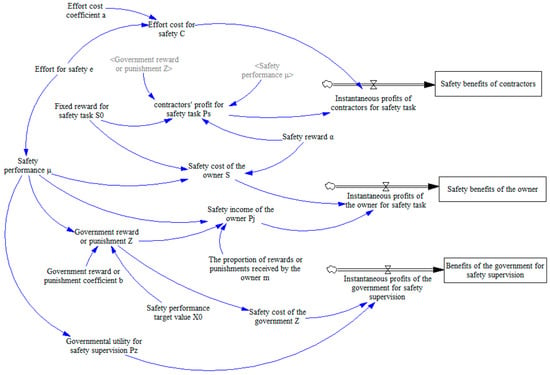
Figure 1.
Flowchart of the proposed model.
Accurate values of parameters are difficult to obtain in many cases. However, this is not a major concern because a system dynamics model in the context considered is concerned with the overall behavioral trend and the influence of changes in policy and thus does not demand accurate results. It has been noted in past work that the structure of the system dynamics model is more important than the values of its parameters [44]. The values of the external variables of our model were obtained from the empirical situation of a target enterprise. The initial values of the parameters were set as shown in Table 1, and the other parameters were calculated using the above formulas. The initial conditions were set as follows: initial time = 0, final time = 100 (month), and time step = 1.

Table 1.
Initial values of the parameters.
The benefits of safety are important for contractors because accidents incur large fines for them and make owners less likely to hire them in the future. The rate of profits and the accumulated safety-related profits of the contractors are shown in Figure 2 and Figure 3. The rate of profit (Figure 2) showed a trend of increasing in the first few decades and then declining. Contractors need to pay a certain construction safety cost in the early stages, and it will take some time to obtain safety benefits, so the benefits to contractors for ensuring safety (Figure 3) exhibited a trend of decline in the short term and an increase in the medium term. As the cost of ensuring safety increased, it eventually exhibited a trend of decline.
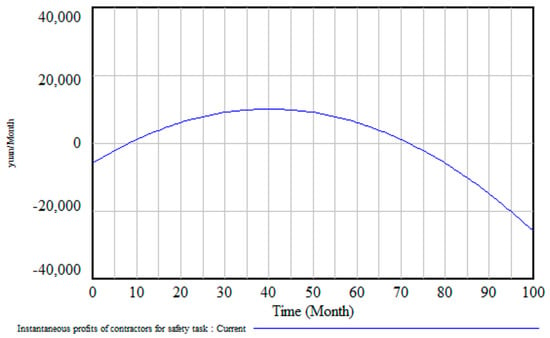
Figure 2.
The instantaneous profits for contractors.
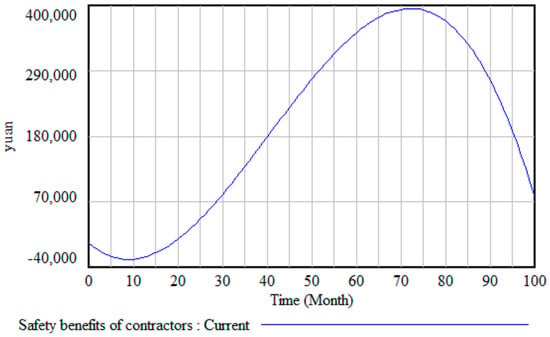
Figure 3.
The safety-related profits for contractors.
The owner’s income from ensuring safety (Figure 4) showed a trend of decline followed by an increase. Because the owner needed to issue part of the reward to the contractor, their safety-related income decreased in the short term and even became negative. Improvements in the level of effort by contractors to ensure safety showed a trend toward an increase in the long run.
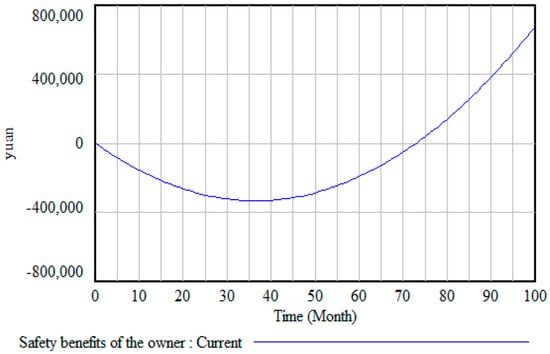
Figure 4.
The safety-related profits of the owner.
The goal of the government is supervision and regulation. Figure 5 shows that as the level of effort to ensure safety increased, the government’s expenditure increased because its rewards to the owners and contractors increased. Thus, the government’s safety-related income declined when safety was ensured. The higher its rewards and punishments were, the more prominent the downward trend.
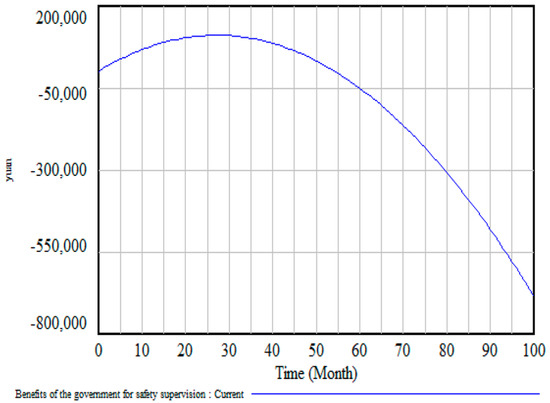
Figure 5.
The profits from ensuring the safety of the government.
5.2. Analysis of Results
Because the entire supervision process is dynamic, contractors are motivated by the government’s supervision to ensure safety. This study proposes two strategies to analyze the influence of the government’s coefficient of reward or punishment on the benefits of safety through simulations. Strategy 1: This study sets the government’s coefficient of reward or punishment at four. Strategy 2: This study sets the government’s coefficient of reward or punishment at six. This study substituted the values of the parameters of these strategies into the model to obtain the results.
Figure 6 shows that in the first 10 months, the contractors’ income from ensuring safety by adopting strategy 1 was slightly higher than that obtained from strategy 2, and both strategies showed a trend of decline over time. For a long period in the middle, the rate of growth of income from ensuring safety obtained by adopting strategy 2 was higher than that from strategy 1. After 75 months, the benefit for contractors began to decline sharply under strategy 1, but continued to rise under strategy 2. The latter exhibited a downward trend after 85 months, but the overall benefits of strategy 2 were still far higher than those of strategy 1. Increasing the government’s coefficient of reward or punishment led to a decrease in the contractor’s income from safety in the first 41 months, but it subsequently increased.
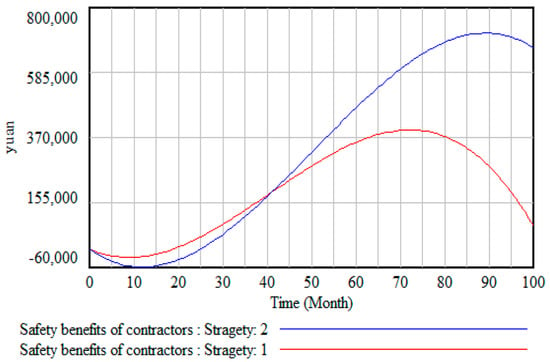
Figure 6.
Comparison of the trends in changes to the contractor’s income from ensuring safety under the two strategies.
Figure 7 shows that in the first 30 months, the benefits for the owner under strategy 1 were slightly higher than those under strategy 2, but both showed a downward trend over time. The owner’s benefits subsequently began to rise under strategy 2, but continued to decline under strategy 1, finally rising after 41 months. The rate of growth of benefits was slower than that under strategy 2. An increase in the government’s coefficient of reward or punishment in the first 41 months led to a decrease in the owner’s income, which then increased.
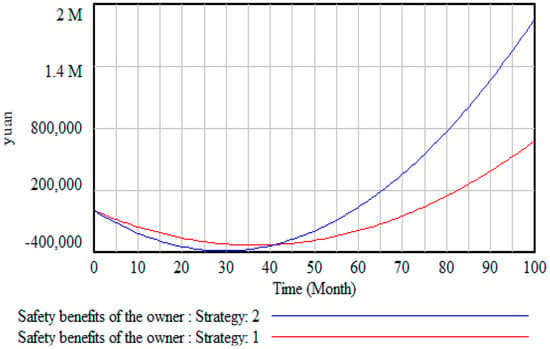
Figure 7.
Comparison of the trends in changes to the owner’s income from ensuring safety under the two strategies.
Figure 8 shows that in the first 25 months, the benefits for the government of supervising safety under strategy 2 were slightly higher than those under strategy 1, but both showed a trend of increasing. These benefits then began to decline under strategy 2, but continued to increase under strategy 1, eventually declining. The final profit from ensuring safety under strategy 2 was much lower than that under strategy 1. An increase in the government’s coefficient of reward or punishment in the first 41 months led to an increase in the benefits for it, which then declined.
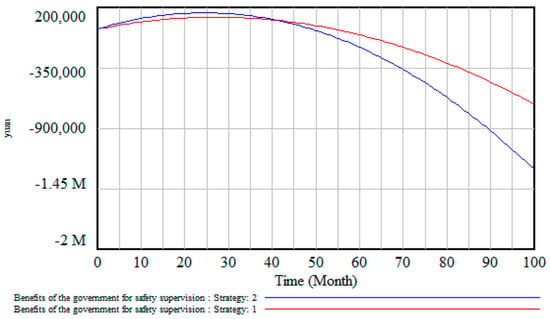
Figure 8.
Comparison of the trends in changes in the government’s benefits from ensuring safety under the two strategies.
In the short term, increasing the government’s coefficient of reward or punishment led to lower benefits for contractors and owners for ensuring safety during construction but higher benefits for the government. In the long run, the benefits for contractors and owners increased significantly, while the government had to provide significant incentives to them for their good performance. Increasing the coefficient of reward or punishment thus motivates enterprises to ensure safety but increases the cost to the government. Increasing the government’s coefficient of reward or punishment over different periods did not lead to an increase in benefits for all three parties. Therefore, the government should formulate a reasonable coefficient of reward or punishment to ensure safe construction, and owners play the most important role in this context.
6. Conclusions and Suggestions
This study proposed a model of incentives for managing safety during construction involving the government, owners of construction companies, and contractors by analyzing the current mode of safety supervision, past research, incentive theory, and principal–agent theory. This study used it to analyze the relationships among the three parties under the optimal strategy through simulations in Vensim. The following conclusions can be drawn:
- (1)
- When the contractor invests more effort to ensure safety, their benefits are higher. If the expected benefit is not achieved, the contractor becomes lax regarding safety and invests less effort in it. The government’s safety-related incentives increase the expected benefits for the contractors.
- (2)
- The government motivates the management of safety during construction through rewards and punishments, and owners motivate contractors to ensure safety through appropriate remuneration.
- (3)
- When the government increases its safety-related incentives, this prompts contractors to invest more effort and the owners to invest more human, financial, and material resources for safety supervision. This, in turn, reduces the income of contractors and owners in the short term but increases their benefits in the long run.
The following suggestions for the government can be made:
- (1)
- It is important for the government to establish a system of accountability and strengthen rewards and punishments to ensure safety during construction. The government can improve the bidding mechanism for construction, introduce a safety credit rating for contractors, determine the maximum safety standards that the contractors can achieve, estimate the performance of construction companies in terms of ensuring safety, and formulate a feasible and efficient coefficient of reward or punishment.
- (2)
- The government should adjust the tax rate according to the management of safety by contractors to encourage them to improve their performance. In this way, contractors can improve safety during construction while maximizing their own benefits.
- (3)
- The government should formulate a policy of subsidies for construction safety to incentivize contractors with good safety-related performance to reduce accidents.
- (4)
- The contractor’s safety-related performance is linked to their economic interests, which can reduce the insurance rate for contractors with good safety production, thereby reducing the investment cost of enterprises and effectively encouraging contractors to improve their safety management level and safety performance.
- (5)
- The government can reward the owners according to whether the safety production of the construction project is good under the supervision of the owners, so as to encourage the owners to actively strengthen the safety supervision of the contractors, implement the safety supervision responsibilities, and improve the safety performance.
The following suggestions for the owners can be made:
- (1)
- The owners of construction companies should use the qualifications of different contractors and their past safety-related performance to ensure that they choose competent professionals.
- (2)
- The management of safety during construction runs through the entire project, which spans a long period, and contractors are often reluctant to take the relevant measures out of a preference for the pursuit of immediate benefits. It can increase the net benefits of contractors by taking safety measures and promoting and helping contractors control the occurrence of safety accidents by establishing a self-restraining management mechanism so as to realize the self-regulation of contractors’ safety control behaviors.
7. Limitations and Future Research
This study explored the objective indicators influencing the management of safety during construction. Future research in the area should also consider subjective factors, such as overconfidence among workers and a preference for fairness, to diversify the proposed model.
Author Contributions
Conceptualization, Q.F.; methodology, X.S.; software, K.W.; validation, J.W.; formal analysis, Q.F.; investigation, K.W. and Y.F.; resources, Y.F.; data curation, K.W. and Y.R.; writing—original draft preparation, Q.F.; writing—review and editing, X.S.; visualization, Y.R.; supervision, Q.F.; project administration, X.S.; funding acquisition, Q.F. and X.S. All authors have read and agreed to the published version of the manuscript.
Funding
This research was funded by the National Social Science Funding of China (21CJY027), the Natural Science Foundation of Shandong Province (ZR2021MG049 and ZR2022MA079), the China postdoctoral foundation project (2019M652420), the Research Foundation of the University (19YY08), and the SCEGC-XJTU Joint Research Center for Future City Construction and Management Innovation Foundation (SKH2021284).
Data Availability Statement
Data generated or analyzed during the study are available from the corresponding author by request.
Acknowledgments
Acknowledgments to the experts and students who provided assistance in the research, as well as to the journal editors and reviewers for their work.
Conflicts of Interest
The authors declare that we have no competing financial interests or personal relationships that could have appeared to influence the work reported in this paper.
References
- Zhou, X.-H.; Shen, S.-L.; Xu, Y.-S.; Zhou, A.-N. Analysis of Production Safety in the Construction Industry of China in 2018. Sustainability 2019, 11, 4537. [Google Scholar] [CrossRef]
- Gao, Y.; Fan, Y.; Wang, J.; Duan, Z. Evaluation of governmental safety regulatory functions in preventing major accidents in China. Saf. Sci. 2019, 120, 299–311. [Google Scholar] [CrossRef]
- Li, Y.; Kang, T.G. Study on Building Safety Economic Incentive Mechanism. Appl. Mech. Mater. 2013, 368, 1913–1916. [Google Scholar] [CrossRef]
- Meng, Q.; Liu, Y.; Li, Z.; Wu, C. Dynamic reward and penalty strategies of green building construction incentive: An evolutionary game theory-based analysis. Environ. Sci. Pollut. Res. 2021, 28, 44902–44915. [Google Scholar] [CrossRef] [PubMed]
- Liu, J.; Wang, X.; Liu, T. Behavior Choice Mechanisms and Tax Incentive Mechanisms in the Game of Construction Safety. Buildings 2022, 12, 1078. [Google Scholar] [CrossRef]
- Guo, B.H.; Goh, Y.M.; Wong, K.L.X. A system dynamics view of a behavior-based safety program in the construction industry. Saf. Sci. 2018, 104, 202–215. [Google Scholar] [CrossRef]
- Shin, M.; Lee, H.-S.; Park, M.; Moon, M.; Han, S. A system dynamics approach for modeling construction workers’ safety attitudes and behaviors. Accid. Anal. Prev. 2014, 68, 95–105. [Google Scholar] [CrossRef]
- Kim, N.K.; Rahim, N.F.A.; Iranmanesh, M.; Foroughi, B. The role of the safety climate in the successful implementation of safety management systems. Saf. Sci. 2019, 118, 48–56. [Google Scholar] [CrossRef]
- Kerkhove, L.; Vanhoucke, M. Incentive contract design for projects: The owner’s perspective. Omega 2016, 62, 93–114. [Google Scholar] [CrossRef]
- Suprapto, M.; Bakker, H.L.M.; Mooi, H.G.; Hertogh, M.J.C.M. How do contract types and incentives matter to project performance? Int. J. Proj. Manag. 2016, 34, 1071–1087. [Google Scholar] [CrossRef]
- Yan, L.; Guo, L.; Ning, Y. Understanding Construction Contractors’ Intention to Undertake Consummate Performance Behaviors in Construction Projects. Adv. Civ. Eng. 2020, 2020, 3935843. [Google Scholar] [CrossRef]
- Ning, X.; Qiu, Y.; Wu, C.; Jia, K. Developing a Decision-Making Model for Construction Safety Behavior Supervision: An Evolutionary Game Theory-Based Analysis. Front. Psychol. 2022, 13, 861828. [Google Scholar] [CrossRef]
- Bu, X. The Operation and Feedback Mechanism of Building Construction Safety Supervision Management Mode. In Proceedings of the 2016 International Conference on Economy, Management and Education Technology, Chongqing, China, 28–29 May 2016; Atlantis Press: Amsterdam, The Netherlands, 2016; pp. 76–81. [Google Scholar] [CrossRef]
- Laffont, J.-J.; Martimort, D. The Theory of Incentives. In The Theory of Incentives; Princeton University Press: Princeton, NJ, USA, 2002. [Google Scholar] [CrossRef]
- Huang, X.; Hinze, J. Owner’s role in construction safety. J. Constr. Eng. Manag. 2006, 132, 164–173. [Google Scholar] [CrossRef]
- Cheng, G.Y.; Weng, Y.F.; Cheng, Y. The Strategic Planning and System Analysis of Safety Supervision. Appl. Mech. Mater. 2013, 401, 2280–2284. [Google Scholar] [CrossRef]
- Pesek, A.E.; Smithwick, J.B.; Saseendran, A.; Sullivan, K.T. Information Asymmetry on Heavy Civil Projects: Deficiency Identification by Contractors and Owners. J. Manag. Eng. 2019, 35, 694. [Google Scholar] [CrossRef]
- Park, J.; Park, S.; Oh, T. The development of a web-based construction safety management information system to improve risk assessment. KSCE J. Civ. Eng. 2014, 19, 528–537. [Google Scholar] [CrossRef]
- Pi, Z.; Gao, X.; Chen, L.; Liu, J. The New Path to Improve Construction Safety Performance in China: An Evolutionary Game Theoretic Approach. Int. J. Environ. Res. Public Health 2019, 16, 2443. [Google Scholar] [CrossRef]
- Zhang, Y.; Yi, X.; Li, S.; Qiu, H. Evolutionary game of government safety supervision for prefabricated building construction using system dynamics. Eng. Constr. Arch. Manag. 2022. ahead-of-print. [Google Scholar] [CrossRef]
- Zhang, L.; Chen, H.; Li, H.; Wu, X.; Skibniewski, M.J. Perceiving interactions and dynamics of safety leadership in construction projects. Saf. Sci. 2018, 106, 66–78. [Google Scholar] [CrossRef]
- Lafuente, E.; Abad, J. Analysis of the relationship between the adoption of the OHSAS 18001 and business performance in different organizational contexts. Saf. Sci. 2018, 103, 12–22. [Google Scholar] [CrossRef]
- Mohammadi, A.; Tavakolan, M.; Khosravi, Y. Factors influencing safety performance on construction projects: A review. Saf. Sci. 2018, 109, 382–397. [Google Scholar] [CrossRef]
- Griffin, M.A.; Hu, X. How leaders differentially motivate safety compliance and safety participation: The role of monitoring, inspiring, and learning. Saf. Sci. 2013, 60, 196–202. [Google Scholar] [CrossRef]
- Sparer, E.H.; Dennerlein, J.T. Determining safety inspection thresholds for employee incentives programs on construction sites. Saf. Sci. 2013, 51, 77–84. [Google Scholar] [CrossRef] [PubMed]
- Xia, N.; Tang, Y.; Li, D.; Pan, A. Safety Behavior among Construction Workers: Influences of Personality and Leadership. J. Constr. Eng. Manag. 2021, 147, 04021019. [Google Scholar] [CrossRef]
- Ji, L.; Liu, W.; Zhang, Y. Research on the Tournament Incentive Mechanism of the Safety Behavior for Construction Workers: Considering Multiple Heterogeneity. Front. Psychol. 2021, 12, 796295. [Google Scholar] [CrossRef] [PubMed]
- Karakhan, A.; Gambatese, J. Hazards and Risk in Construction and the Impact of Incentives and Rewards on Safety Outcomes. Pract. Period. Struct. Des. Constr. 2018, 23, 359. [Google Scholar] [CrossRef]
- Chughtai, A.A. Creating safer workplaces: The role of ethical leadership. Saf. Sci. 2015, 73, 92–98. [Google Scholar] [CrossRef]
- Liang, F.S. Research on incentive mechanisms of building construction safety management. In Proceedings of the CRIOCM 2006 International Symposium on “Advancement of Construction Management and Real Estate, Beijing, China, 3–5 November 2006; Volume 1, pp. 259–265. [Google Scholar]
- Wu, G.; Zuo, J.; Zhao, X. Incentive Model Based on Cooperative Relationship in Sustainable Construction Projects. Sustainability 2017, 9, 1191. [Google Scholar] [CrossRef]
- Guo, S.; Zhang, P.; Yang, J. System dynamics model based on evolutionary game theory for quality supervision among construction stakeholders. J. Civ. Eng. Manag. 2018, 24, 318–330. [Google Scholar] [CrossRef]
- Feng, J.; Wang, Y.; Zhang, K. Evaluation of the Quality Supervision System for Construction Projects in China Considering the Quality Behavior Risk Transmission. Symmetry 2020, 12, 1660. [Google Scholar] [CrossRef]
- Alarcón, L.F.; Acuña, D.; Diethelm, S.; Pellicer, E. Strategies for improving safety performance in construction firms. Accid. Anal. Prev. 2016, 94, 107–118. [Google Scholar] [CrossRef]
- Liu, J.; Wang, X.; Nie, X.; Lu, R. Incentive Mechanism of Construction Safety from the Perspective of Mutual Benefit. Buildings 2022, 12, 536. [Google Scholar] [CrossRef]
- Hasan, A.; Jha, K.N. Safety incentive and penalty provisions in Indian construction projects and their impact on safety performance. Int. J. Inj. Control. Saf. Promot. 2013, 20, 3–12. [Google Scholar] [CrossRef]
- Chen, S.; Hu, Z.G.; Liu, Q.; Guo, J. Incentive mechanism design for safety management of hydropower construction. J. Syst. Eng. 2012, 4, 474–480. [Google Scholar]
- Meng, X.; Gallagher, B. The impact of incentive mechanisms on project performance. Int. J. Proj. Manag. 2012, 30, 352–362. [Google Scholar] [CrossRef]
- Rose, T.; Manley, K. Motivation toward financial incentive goals on construction projects. J. Bus. Res. 2011, 64, 765–773. [Google Scholar] [CrossRef]
- Chen, Y.; Chen, H. The Collective Strategies of Key Stakeholders in Sponge City Construction: A Tripartite Game Analysis of Governments, Developers, and Consumers. Water 2020, 12, 1087. [Google Scholar] [CrossRef]
- Kang, L.; Wu, C. Evaluating the safety performance of china’s provincial construction industries from 2009 to 2017. J. Civ. Eng. Manag. 2020, 26, 435–446. [Google Scholar] [CrossRef]
- Feng, Y. Effect of safety investments on safety performance of building projects. Saf. Sci. 2013, 59, 28–45. [Google Scholar] [CrossRef]
- Feng, Y.; Teo, E.A.L.; Ling, F.Y.Y.; Low, S.P. Exploring the interactive effects of safety investments, safety culture and project hazard on safety performance: An empirical analysis. Int. J. Proj. Manag. 2014, 32, 932–943. [Google Scholar] [CrossRef]
- Wu, D.D.; Kefan, X.; Hua, L.; Shi, Z.; Olson, D.L. Modeling technological innovation risks of an entrepreneurial team using system dynamics: An agent-based perspective. Technol. Forecast. Soc. Chang. 2010, 77, 857–869. [Google Scholar] [CrossRef]
Disclaimer/Publisher’s Note: The statements, opinions and data contained in all publications are solely those of the individual author(s) and contributor(s) and not of MDPI and/or the editor(s). MDPI and/or the editor(s) disclaim responsibility for any injury to people or property resulting from any ideas, methods, instructions or products referred to in the content. |
© 2023 by the authors. Licensee MDPI, Basel, Switzerland. This article is an open access article distributed under the terms and conditions of the Creative Commons Attribution (CC BY) license (https://creativecommons.org/licenses/by/4.0/).